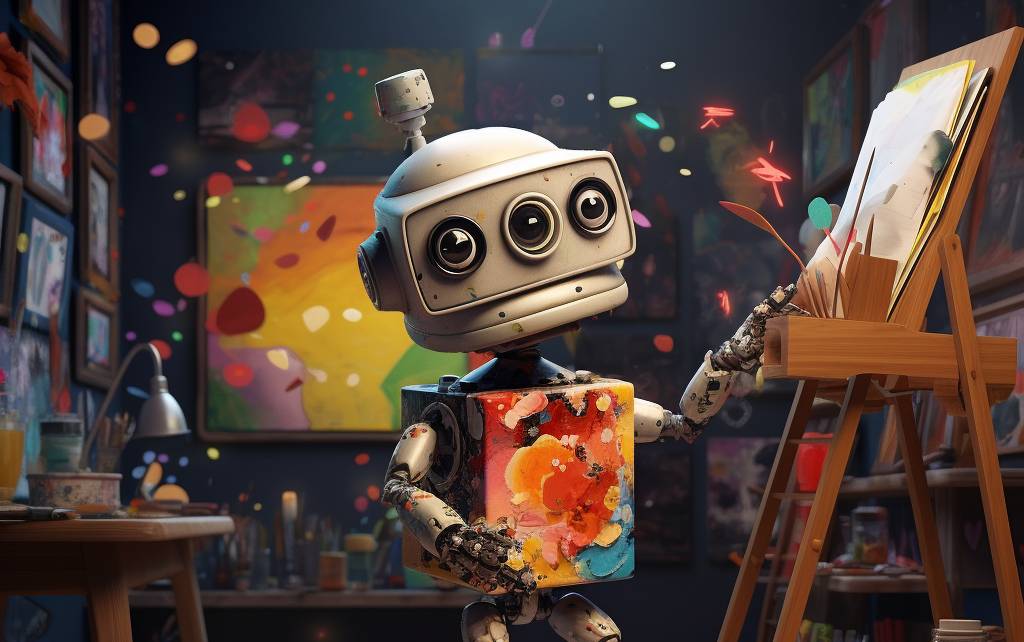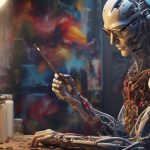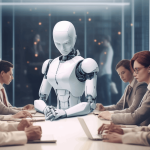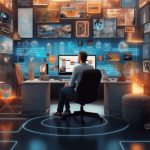AI Renaissance: The intersection of creativity and artificial intelligence (AI)
Artificial intelligence (AI) has made significant advancements in recent years, revolutionising various industries. One area where AI has had a profound impact is creativity. Traditionally, creativity has been viewed as a purely human endeavour, but with the advent of AI, we are witnessing the emergence of a new era: the AI Renaissance. We will explores the fascinating collaboration between creativity and AI, investigating its role in creative production, the tools available to creative professionals and the future implications of this partnership.
The role of AI in creative production
AI has transformed the creative landscape by offering new possibilities and augmenting human capabilities. It is no longer limited to mundane tasks but has evolved to become an active participant in the creative process. With its ability to analyse vast amounts of data, AI can generate insights, identify patterns, and even make predictions. This analytical power enables AI to assist creative professionals in generating innovative ideas, enhancing their productivity, and pushing the boundaries of what is possible.
Moreover, AI algorithms can process and understand diverse forms of creative content, such as images, videos, and music. By analysing existing works, AI can learn and mimic various artistic styles, enabling it to create original pieces that are indistinguishable from those produced by humans. This opens up new avenues for artistic expression and encourages experimentation in the creative field.
AI-powered tools for creative professionals
AI-powered tools have become indispensable for creative professionals, empowering them to achieve unprecedented levels of productivity and efficiency. One such tool is AI-powered image editing software. These applications utilise deep learning algorithms to automatically enhance, retouch, and manipulate images, saving artists valuable time and effort. The software can analyse an image and suggest edits, allowing artists to focus on their creative vision rather than tedious manual adjustments.
Similarly, AI-based music composition tools have revolutionised the music industry. These tools can analyse vast music libraries, identify patterns, and generate original compositions based on specific genres or moods. They enable musicians to explore new musical landscapes, experiment with different styles, and compose music that resonates with their audience.
Examples of AI-driven creativity in various industries
AI-driven creativity is not limited to a specific industry; it has permeated various sectors, showcasing its immense potential. In the film industry, AI has been used to create stunning visual effects and realistic characters. For instance, in the movie “Avengers: Endgame,” AI was employed to de-age the actors and bring back iconic characters from the past. This technology revolutionised the way visual effects are created, providing filmmakers with unprecedented creative possibilities.
In the field of marketing, AI has been harnessed to personalise advertisements and optimise campaigns. By analysing consumer data and preferences, AI algorithms can generate highly targeted and compelling advertisements that resonate with specific audiences. This not only enhances the effectiveness of marketing efforts but also allows brands to connect with consumers on a more personal level.
The impact of AI on the creative process
The integration of AI into the creative process has had a profound impact on how ideas are generated, developed, and executed. AI algorithms can analyse vast amounts of data, including customer feedback, market trends, and historical data, to identify patterns and insights that humans may overlook. This data-driven approach enables creative professionals to make informed decisions, reduce risks, and tailor their work to meet the demands and preferences of their target audience.
Moreover, AI can act as a collaborator, providing suggestions and feedback during the creative process. It can offer alternative ideas, identify potential flaws, and even predict the success of a creative endeavour. This collaborative aspect of AI not only enhances the quality of the final product but also fosters innovation and encourages creative professionals to explore new territories.
The future of AI and creativity
The AI Renaissance is just the beginning. As AI continues to advance, we can expect even more profound transformations in the creative landscape. AI algorithms will become more sophisticated, enabling them to understand complex human emotions, context, and subtleties. This will allow AI to generate creative content that not only meets technical standards but also evokes genuine emotional responses in the audience.
Furthermore, the integration of AI with emerging technologies such as virtual reality (VR) and augmented reality (AR) will unlock exciting possibilities for immersive and interactive creative experiences. AI-powered VR and AR applications can adapt to user preferences, creating personalised and dynamic experiences that blur the line between the real and virtual worlds.
Ethical considerations in AI-driven creativity
As AI becomes increasingly involved in the creative process, it is crucial to address the ethical considerations surrounding AI-driven creativity. One key concern is the potential for AI to replace human creatives entirely. While AI can augment human capabilities, it should be seen as a tool rather than a replacement. Human creativity is driven by emotions, intuition, and subjective experiences that are difficult to replicate artificially. Therefore, it is essential to strike a balance between AI and human collaboration to preserve the unique qualities that humans bring to the creative process.
Another ethical consideration is the responsibility of AI creators and users to ensure that AI-generated content is used ethically and responsibly. AI algorithms can potentially be used to manipulate and deceive, leading to misinformation or unethical practices. It is crucial to establish guidelines, regulations, and ethical frameworks to govern the use of AI in creative industries and ensure transparency and accountability.
Overcoming scepticism and embracing AI in creative fields
Despite the numerous benefits of AI in creative fields, there is often scepticism and resistance towards its adoption. Some fear that AI will replace human creatives, while others worry about the loss of originality and authenticity. However, embracing AI does not mean relinquishing creativity; rather, it is about harnessing the power of AI to amplify human creativity and push the boundaries of what is possible.
To overcome skepticism, education and awareness are key. By understanding the capabilities and limitations of AI, creative professionals can identify opportunities where AI can enhance their work and improve their productivity. Moreover, fostering a culture of collaboration between AI and human creatives can help build trust and confidence in AI-driven creativity.
AI and human collaboration: The perfect partnership
The true potential of AI-driven creativity lies in the collaboration between AI and human creatives. While AI algorithms can analyse data and generate ideas, humans provide the emotional intelligence, intuition, and subjective experiences that are crucial for creating meaningful and impactful works of art. By leveraging AI as a tool and partner, creative professionals can unlock new levels of innovation, efficiency, and creativity.
This partnership also opens up new avenues for interdisciplinary collaborations. AI can bridge the gap between different creative disciplines, enabling artists, musicians, filmmakers, and designers to collaborate and create unique, multidimensional experiences. The collective intelligence of AI and human creatives can lead to unprecedented results that would be difficult to achieve independently.
Conclusion: Embracing the AI renaissance in creative industries
The AI Renaissance is transforming the creative landscape, offering new possibilities and pushing the boundaries of human creativity. AI-powered tools and algorithms are augmenting human capabilities, enabling creative professionals to achieve unprecedented levels of productivity and efficiency. From film and marketing to music and art, AI-driven creativity is permeating various industries, revolutionising the way we create, experience, and interact with creative content.
As we embrace this AI renaissance, it is essential to address the ethical considerations, foster collaboration between AI and human creatives, and overcome scepticism. By leveraging the unique strengths of both AI and human creativity, we can unlock the true potential of this collaboration and create a future where AI and human ingenuity coexist harmoniously, leading to unparalleled creative achievements.

I am here to make this site great with the help of the community.





